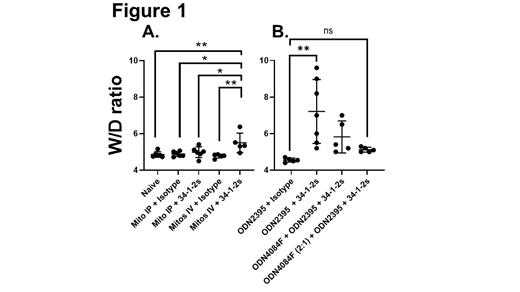Transfusion-related acute lung injury (TRALI) is potentially life-threatening and has been ranked as the leading cause of transfusion-related fatalities since its description in the 1980s. With a 5 to 14% mortality rate, symptoms range from mild dyspnea, cough and fever to full-blown respiratory failure and severe hypoxemia, which usually occurs within 6 hours from the transfusion. To date, the pathogenesis is not fully understood, but it appears that TRALI requires two hits in order to be initiated; the first-hit is the patient's clinical condition often reflected by a state of inflammation while the second hit is the transfusion itself. Several published articles have shown that mitochondrial damage-associated molecular patterns (mtDAMPs) including extracellular mitochondria and mitochondrial DNA (mtDNA) are elevated in stored transfusion products that have been linked to adverse transfusion reactions. Using an in vivo murine model of TRALI where injection of a monoclonal anti-MHC class I antibody (34-1-2s) into LPS-primed BALB/c mice causes significant lung edema, we explored the possibility of whether mitochondria and mtDAMPs could act as first hits in TRALI induction. Mitochondria were prepared from mouse livers by differential centrifugation and purified on a density gradient. Intravenous injections of only mitochondria (2.5 x 10 8 per mouse) prior to injection with 34-1-2s caused TRALI characterized by significantly elevated lung wet/dry ratios (Figure 1A), temperature loss and lung neutrophil accumulation. In contrast, however, intraperitoneal injections of mitochondria did not prime as a first hit for 34-1-2s-induced TRALI suggesting that the route of the mitochondrial first hit is important in determining whether TRALI proceeds (Figure 1A.). Using a TLR9 agonist (ODN2395) to mimic mtDNA as a first hit, we also observed 34-1-2s-induced TRALI induction, and this could be prevented by the administration of a specific TLR9 antagonist (ODN4084F) 2h before the ODN2395 injection (Figure 1B). Of interest, the TLR9 antagonist was not sufficient to prevent TRALI induced by the iv whole mitochondria first hit, indicating that other mtDAMPS are also involved in the priming of the mice for TRALI. This study suggests that mitochondria and at least mtDNA can act as a first hit in antibody-mediated TRALI via stimulation of recipient TLR9 and that the first hit route maybe important in stimulating TRALI. Further investigations are underway to identify other mtDAMPS (such as N-formyl peptides) or a combination of DAMPs that are important for the first hit. Inhibition of mitochondrial DAMPS may be a potential therapy for transfusion recipients suffering from TRALI.
Disclosures
No relevant conflicts of interest to declare.


This feature is available to Subscribers Only
Sign In or Create an Account Close Modal